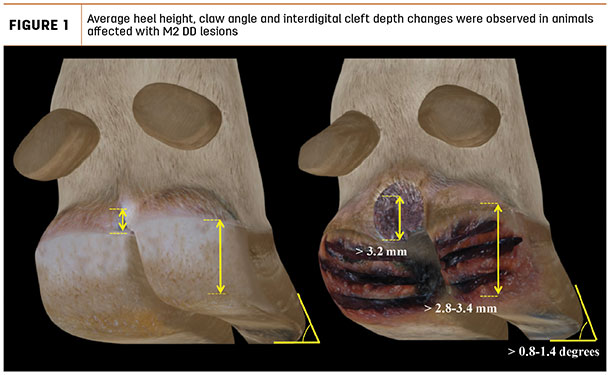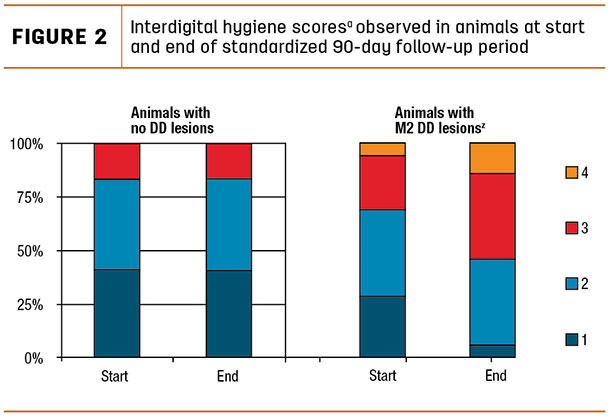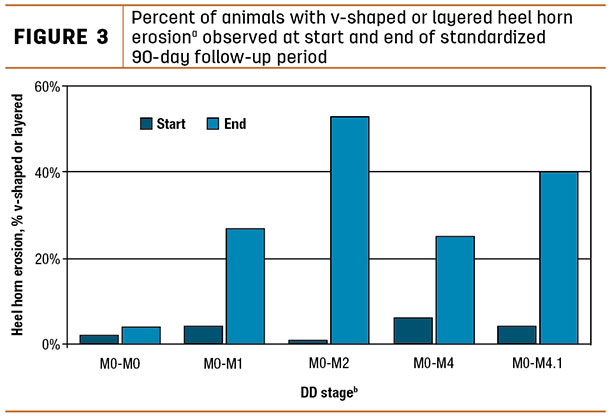When severe cases of digital dermatitis (DD) are identified in the field, it is common to find “square” feet, characterized by overgrown heels and shortened claws. These animals typically exhibit visible signs of lameness due to active, painful DD lesions (M2 stage), as well as a marked transformation of the original claw shape.
However, very little is actually known about the potential effects on hoof conformation caused by DD during early clinical stages. A knowledge gap also exists regarding the relationship between DD and other hoof diseases over time.
For example, an association between heel horn erosion (a lesion of the heel area generally attributed to lack of hygiene and often observed during the same time periods of high DD risk) and DD has been shown in studies, but its exact relationship to DD over time has remained unclear.
In order to better describe how active DD lesions impact hoof conformation and to evaluate the relationship between DD and heel horn erosion over time, researchers at the University of Wisconsin, led by Dr. Dörte Döpfer and with support from Zinpro Corporation, initiated a study at a commercial dairy operation endemically infected with digital dermatitis.
Study design
A total of 644 Holstein heifers were recruited for the study. Heifers were eligible for enrollment if, during initial evaluation, they were pregnant and free of foot skin/horn diseases such as DD, heel horn erosion and interdigital dermatitis. DD, hoof conformation and the presence of heel horn erosion in the rear feet of each heifer were assessed during a period of six months.
During each of the evaluation periods, body measurements (hip height and heart-girth circumference), DD diagnosis and hoof conformation were assessed and recorded based on the following measurement techniques and classification systems.
- Hoof measurements were taken from the right and left rear legs and included the dorsal wall length, total claw length, heel height and angle of both medial and lateral claws.
- The depth and hygiene of the interdigital space were also evaluated in each foot, as well as the amount of heel horn erosion.
- Hygiene of the interdigital space was classified using a 4-point scale depending on the level of debris accumulation (1 = clean interdigital skin, 2 = discontinuous accumulation of debris, 3 = continuous accumulation of debris and 4 = complete filling of the interdigital space).
- Heel horn erosion was classified in four categories depending on the number and shape of the erosion (none, diffuse, V-shaped and layered).
- DD lesions were characterized by their size, presence of proliferation (4-point scale in ascending severity: none, scale, mass-like and filamentous) and location (heel, interdigital, dorsal or other location).
A 5-point DD scale (M0 = healthy, M1 = early lesions, M2 = clinical DD form with lesions less than 2 centimeters, M3 = healing, M4 and M4.1 = chronic and reactivating stages of DD) was used to classify the DD lesion stages. Upon detection of an M2 DD lesion, a topical treatment was applied. Other DD stages were left untreated. No footbaths were used during the study period.
Key research findings
Significant hoof conformation changes were observed in DD-affected feet. Results (standardized to a period of 90 days of follow-up) showed an increase in heel height and claw angle of the medial and lateral claws, respectively (Figure 1).

To reduce discomfort associated with DD, cattle tend to stand on their claws (weight toward the toe), taking weight off their heels. As a consequence of the increase in claw heel height, and given that the claw length remained unchanged, a significant increase in claw angle was also observed in feet affected by M2 DD in this study.
An increase in depth of the interdigital cleft (Figure 1) and in debris accumulation (Figure 2) was also observed.
 Previous research has reported the association between the depth of the interdigital space and DD occurrence. However, that previous research did not establish a relationship over time between deep interdigital spaces and DD infection.
Previous research has reported the association between the depth of the interdigital space and DD occurrence. However, that previous research did not establish a relationship over time between deep interdigital spaces and DD infection.
Results from this study demonstrated that significant changes of the interdigital space depth occurred in animals experiencing an M2 DD lesion, and that was not observed in healthy animals. Inflammation of skin tissue and prominence of the DD lesion in relation to the surrounding healthy skin can explain the observed increase in depth of the interdigital space.
Once the disease is established, deeper interdigital spaces can favor anaerobic environments and potentially facilitate the development of DD stages, resulting in increased bacterial growth and disease recurrence.
Feet affected with clinical DD lesions also experienced a 46 percent increase in severe heel horn erosion. The association among heel horn erosion, interdigital dermatitis and DD has been largely reported in previous literature.
This association has been attributed to the fact that DD, interdigital dermatitis and heel horn erosion share common risk factors such as wet and muddy environments, and some bacterial species have been found in all three diseases.
For the first time, an association has been shown between DD and layered heel horn erosion over time. It is believed that the occurrence of a clinical DD event initiates the ideal conditions for the development of more severe heel horn erosion (Figure 3).
 Less severe cases of DD (M1, M4 and M4.1) also demonstrated a tendency to modify hoof conformation (depth of the interdigital cleft and heel horn erosion) in this study.
Less severe cases of DD (M1, M4 and M4.1) also demonstrated a tendency to modify hoof conformation (depth of the interdigital cleft and heel horn erosion) in this study.
In the short term, hoof conformation changes returned to normal levels when clinical cure of DD was achieved after topical treatment, with the exception of heel horn erosion lesions that would need further intervention once established.
Conclusion
Significant hoof conformation changes occur in heifers affected by clinical DD even before lameness symptoms are detected. Transformation of the heel area in feet affected by DD likely promotes the creation of a local environment that favors persistence of the disease and the occurrence of severe heel horn erosion.
To avoid hoof damage and prevent further hoof health consequences, active surveillance and early intervention are recommended to improve DD control programs. This will in turn help reduce hoof conformation changes.
Successful restoration of hoof conformation can be achieved upon clinical cure of DD. The long-term effects in lifetime performance of the hoof conformation changes due to DD require further investigation. ![]()
Based on the publication by A. Gomez, N.B. Cook, J. Rieman, K.A. Dunbar, K.E. Cooley, M.T. Socha and D. Döpfer. 2015. J. Dairy Sci. 98:927-936

-
Arturo Gomez
- Dairy Veterinarian – Europe
- Zinpro Corporation








